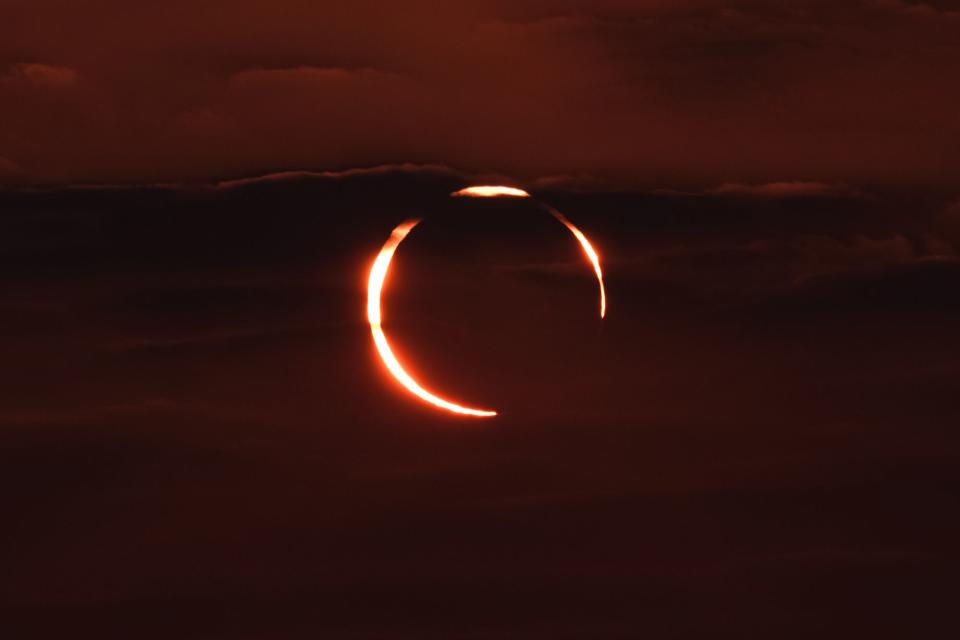A 'Ring of Fire' Eclipse Will Be Visible Across the U.S. This Weekend — What to Know
The U.S. will enjoy two eclipses in the next six months — and the first hits this Saturday

Sorin Furcoi/Getty Images
This Saturday, Oct. 14, a “ring of fire” annular eclipse will dim the skies above a narrow ribbon of the Americas, from the western U.S. into Mexico and Central and South America, and this event is worth traveling for. Saturday’s spectacle — one of the country’s most hyped astronomical events of 2023 — will be the last annular eclipse to create a ring-of-fire effect above the contiguous U.S. until 2046.
Here’s how to see the solar marvel for yourself (with a pair of safe solar eclipse glasses, of course).
What is an annular solar eclipse?
According to NASA, eclipses happen when the Earth, moon, and sun align. For a total solar eclipse, like the buzzed-about spring 2024 event, the moon is close to the Earth and appears large enough to cover virtually the sun’s full disk. The moon-meets-sun marvel is visible to those along a small geographical band, known as the path of totality.
This weekend’s event is different — like a warm-up for what’s to come next year. During an annular eclipse, the moon is further from Earth. For those in the path of annularity, the moon will overlap the sun, but it won’t cover its entirety. Instead, it creates a haunting ring of fire scene with the sun’s fiery fringes bordering the dark lunar orb for roughly three to five minutes, depending on the viewing location. It won’t turn fully dark like a total eclipse, but daylight gets dimmer.
Where to see the annular solar eclipse
The ring of fire is visible in the path of annularity, which includes several western U.S. states: Oregon, Nevada, Utah, Arizona, New Mexico, and Texas, according to NASA. It also travels over Mexico, Guatemala, Belize, Honduras, Nicaragua, Panamá, Colombia, and Brazil. Those near but outside the path will enjoy a partial annular eclipse.
Some of the best U.S. cities to see Saturday’s full annular eclipse include:
Albuquerque, New Mexico: Select hotel and Airbnb bookings are still available within Albuquerque, which will enjoy a lengthy four minutes and 42 seconds of annularity, starting around 10:34 a.m. MDT, according to the Great American Eclipse. Adding to the fun is the annual Albuquerque International Balloon Fiesta, which coincides with the weekend’s solar attraction. It’s the largest piloted balloon event in the world and will host its own eclipse viewing event.
Klamath Falls, Oregon: For just over three minutes, Oregon’s Klamath Falls basin will welcome eerie ring-of-fire annularity — and you can still find hotel and Airbnb availability for a last-minute trip. Try Crater Lake National Park for a scenic eclipse-view spot. Or, join the Fort Klamath EclipseFest (tickets are required).
Bryce Canyon National Park, Utah: Watch Saturday’s interstellar sight — from an equally otherworldly perch: the hoodoo-dotted Bryce Canyon National Park. Hotel and Airbnb options are still available, albeit limited. The region’s show will last for about three minutes. Bryce Canyon expects big crowds, so make sure to get to the park early and try alternative transportation methods, such as the shared bike path or shuttle.
San Antonio, Texas: San Antonio will see a lengthy four minutes and 12 seconds of annularity on Oct. 14, and the city still has several Airbnb and hotel options for catching it. Join the Eclipse Watch at the Alamo, or the NASA-affiliated Fiesta del Sol event at the Scobee Education Center and Planetarium. Fun fact: San Antonio is one of few cities on the path of totality for next year’s eclipse, too.
This Bill Nye-approved map may also help!
How to watch the annular eclipse
You don’t need any special equipment to actually see the eclipse, but NASA says you will need a pair of eclipse glasses to protect your eyes (regular sunglasses won’t do). Make sure to get your glasses sooner than later, and save them for next year’s highly anticipated space event: the 2024 total solar eclipse, which spans from Mexico to Maine, and beyond.
For more Travel & Leisure news, make sure to sign up for our newsletter!
Read the original article on Travel & Leisure.

